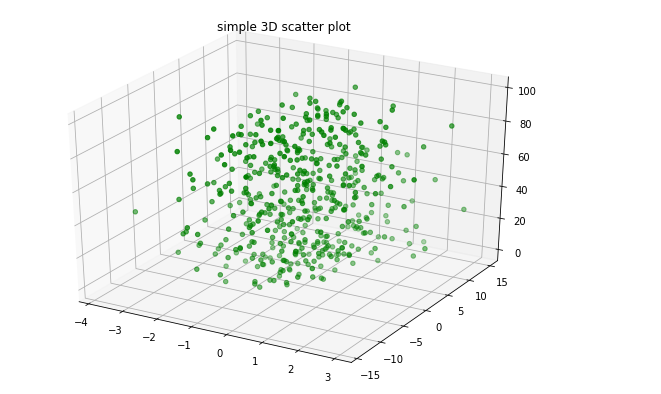

- #SCATTER PLOT MATPLOTLIB TIME HOW TO#
- #SCATTER PLOT MATPLOTLIB TIME UPDATE#
- #SCATTER PLOT MATPLOTLIB TIME FULL#
- #SCATTER PLOT MATPLOTLIB TIME CODE#
- #SCATTER PLOT MATPLOTLIB TIME SERIES#
#SCATTER PLOT MATPLOTLIB TIME FULL#
If “auto”,Ĭhoose between brief or full representation based on number of levels. If “full”, every group will get an entry in the legend. Variables will be represented with a sample of evenly spaced values. Specified order for appearance of the style variable levels You can pass a list of markers or a dictionary mapping levels of the Setting to True will use default markers, or
#SCATTER PLOT MATPLOTLIB TIME HOW TO#
Object determining how to draw the markers for different levels of the Normalization in data units for scaling plot objects when the This kind of plot is useful to see complex correlations between two variables. The coordinates of each point are defined by two dataframe columns and filled circles are used to represent each point. Otherwise they are determined from the data. (x, y, sNone, cNone, kwargs) source Create a scatter plot with varying marker point size and color. Specified order for appearance of the size variable levels, Which forces a categorical interpretation. List or dict arguments should provide a size for each unique data value,

sizes list, dict, or tupleĪn object that determines how sizes are chosen when size is used. Or an object that will map from data units into a interval. hue_norm tuple or Įither a pair of values that set the normalization range in data units Specify the order of processing and plotting for categorical levels of the Imply categorical mapping, while a colormap object implies numeric mapping. String values are passed to color_palette(). Method for choosing the colors to use when mapping the hue semantic. Grouping variable that will produce points with different markers.Ĭan have a numeric dtype but will always be treated as categorical. Grouping variable that will produce points with different sizes.Ĭan be either categorical or numeric, although size mapping willīehave differently in latter case. Grouping variable that will produce points with different colors.Ĭan be either categorical or numeric, although color mapping willīehave differently in latter case. Variables that specify positions on the x and y axes. Either a long-form collection of vectors that can beĪssigned to named variables or a wide-form dataset that will be internally Parameters : data pandas.DataFrame, numpy.ndarray, mapping, or sequence This behavior can be controlled through various parameters, asĭescribed and illustrated below. In particular, numeric variablesĪre represented with a sequential colormap by default, and the legendĮntries show regular “ticks” with values that may or may not exist in theĭata. Represent “numeric” or “categorical” data. Semantic, if present, depends on whether the variable is inferred to The default treatment of the hue (and to a lesser extent, size) Hue and style for the same variable) can be helpful for making Using all three semantic types, but this style of plot can be hard to It is possible to show up to three dimensions independently by Parameters control what visual semantics are used to identify the different Of the data using the hue, size, and style parameters. The relationship between x and y can be shown for different subsets

scatterplot ( data = None, *, x = None, y = None, hue = None, size = None, style = None, palette = None, hue_order = None, hue_norm = None, sizes = None, size_order = None, size_norm = None, markers = True, style_order = None, legend = 'auto', ax = None, ** kwargs ) #ĭraw a scatter plot with possibility of several semantic groupings.
#SCATTER PLOT MATPLOTLIB TIME SERIES#
Here we’ll learn to plot multiple time series in one plot using matplotlib.ĭf1 = pd.DataFrame()ĭf2 = pd.Seaborn.scatterplot # seaborn.

Read: Matplotlib plot_date – Complete tutorial Matplotlib multiple time series plot
#SCATTER PLOT MATPLOTLIB TIME CODE#
Let’s see the source code to create DataFrame: # Import Libraryĭataframe = pd.DataFrame(timeseries_data,columns=)ĭataframe = dataframe.astype("datetime64") The following is the syntax to create DataFrame in Pandas: pandas.DataFrame(data, index, columns, dtype, copy) So firstly, we have to create a sample dataset in pandas. Here we learn to plot a time series plot that will be created in pandas.
#SCATTER PLOT MATPLOTLIB TIME UPDATE#
The field of research for analyzing this data and forecasting future observations is much broader.Īlso, check: Matplotlib update plot in loop Matplotlib time series plot pandas The ECG signal, EEG signal, stock market data, weather data, and so on are all time-indexed and recorded over a period of time. Data visualization plays an important role in plotting time series plots. The Matplotlib module has a method for plotting scatter plots, the two. These observations are made at evenly spaced intervals throughout time. A scatter plot is a graph where each value in the data set is represented as a dot. Time Series data is a collection of data points that were collected over a period of time and are time-indexed. Here first, we will understand what is time series plot and discuss why do we need it in matplotlib.


 0 kommentar(er)
0 kommentar(er)
